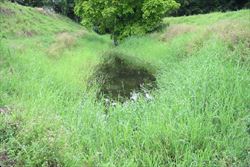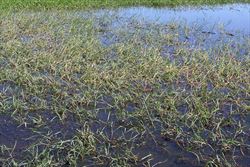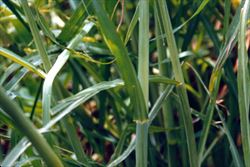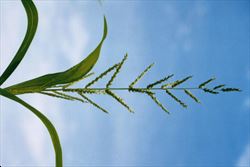Click on images to enlarge

infestation growing around a small water body (Photo: Melissa Collins)

infestation in a wetland area (Photo: Chris Gardiner)

habit (Photo: Melissa Collins)

habit growing in water (Photo: Chris Gardiner)

single flowering stem (Photo: Melissa Collins)

stems and leaves (Photo: Land Protection, QDNRW)

stem and base of leaf blade (Photo: Melissa Collins)

close-up of base of leaf blade showing ligule (Photo: Land Protection, QDNRW)

much-branched seed-head (Photo: Land Protection, QDNRW)

close-up of immature seed-head (Photo: Melissa Collins)
Scientific Name
Echinochloa polystachya (Kunth) Hitchc.
Synonyms
Echinochloa polystachya (Kunth) Hitchc. 'Amity'Pseudechinolaena polystachya (Kunth) Stapf.Oplismenus polystachyus Kunth
Family
Gramineae (South Australia)Poaceae (Queensland, New South Wales, the ACT, Victoria, Tasmania, Western Australia and the Northern Territory)
Common Names
aleman grass, Amity aleman grass, creeping river grass, creeping rivergrass, German grass
Origin
A native of tropical and sub-tropical America from south-eastern USA (i.e. Florida, Lousiana and Texas) through Mexico, Central America (i.e. Belize, Costa Rica, Honduras, Nicaragua and Panama), the Caribbean and northern South America (i.e. French Guiana, Guyana, Surinam, Venezuela, Brazil, Bolivia, Ecuador, Peru, Paraguay, Uruguay and northern Argentina).
Cultivation
Aleman grass (Echinochloa polystachya ) was originally introduced to be used as a ponded pasture grass in northern Australia. It is still cultivated in ponded pastures in this region.
Naturalised Distribution
At present this species has only become naturalised in small areas of northern and central Queensland and the Northern Territory. Populations have been recorded in the Cook, Northen Kennedy, Southern Kennedy, Port Curtis and Leichhardt pastoral districts in Queensland.
Also naturalised in tropical and southern Africa, tropical Asia, Hawaii and beyond its native range in southern South America.
Habitat
A weed of seasonally flooded areas (e.g. floodplains), wetlands, swamps and waterways in tropical regions.
Habit
A robust, vigorous, aquatic or semi-aquatic grass generally growing 1-2.5 m tall, but occasionally reaching up to 3 m in height. It produces long stems (i.e. culms) that tend to grow upright or float on the water surface. It also produces creeping stems (i.e. stolons) that root at the joints (i.e. nodes).
Distinguishing Features
- a large aquatic or semi-aquatic grass usually growing 1-2.5 m tall.
- it is long-lived and spreads via creeping aboveground stems.
- where the leaf sheath meets the leaf blade there is a line of stiff, yellowish, hairs 2-4 mm long.
- its seed-heads are about 15-30 cm long and have numerous branches (2-11 cm long).
- each flower spikelet is topped by either a short projection (1-1.5 mm long) or a much longer awn (7-17 mm long).
Stems and Leaves
The relatively robust flowering stems (7-15 mm thick) are cylindrical and usually have about 7-10 joints (i.e. nodes). These stems are hairless (i.e. glabrous), except at the joints, which sometimes have a tuft of yellowish hairs (i.e. the nodes are hispid).
The leaves are alternately arranged along the stems and sometimes have a reddish or purplish tinge. They consist of a leaf sheath, that partially encloses the stem, and a long and narrow (i.e. linear) leaf blade (20-60 cm long and 10-35 mm wide) that tapers to a narrow tip (i.e. acute apex). Where the leaf sheath meets the leaf blade there is a line of stiff, yellowish, hairs (i.e. ciliated ligule) 2-4 mm long. The leaf sheaths are hairless (i.e. glabrous) or sparsely hairy (i.e. hispid). The leaf blades are flatenned, hairless (i.e. glabrous), smooth, and have rough (i.e. scabrous) margins and a prominent central vein (i.e. midrib).
Flowers and Fruit
The seed-head (15-30 cm long) consists of a main stalk with numerous side-branches (i.e. it is a panicle of racemes). Each of the seed-head branches (i.e. racemes) is 2-11 cm long and has numerous small flower spikelets. These flower spikelets (4.5-7 mm long and 1.7-2.0 mm wide) are elongated in shape (i.e. lanceolate) and borne on very short stalks (i.e. pedicels) 0.5-2 mm long. They consist of two tiny flowers (i.e. florets), only one of which produces a seed, and two outer bracts (i.e. glumes). At the tip of the flower spikelets there may be either a short projection (i.e. a mucro) 1-1.5 mm long or a much longer awn (7-17 mm long). Flowering occurs throughout the year.
The 'seed' (i.e. caryopsis or grain) is contained within the flower spikelets, and is enclosed within several bracts (i.e. the palea, lemma and two glumes). When the seeds are mature, the entire flower spikelet falls off as a whole (i.e. it disarticulates below the glumes).
Reproduction and Dispersal
Aleman grass (Echinochloa polystachya) reproduces by seed and also vegetatively via its creeping stems (i.e. stolons). Seed production is generally thought to be relatively poor in Australia.
Dispersal usually occurs when pieces of the stems or roots are broken off and carried away by flood waters. Seeds may also be dispersed in this manner, as well as in contaminated agricultural produce and mud that becomes attached to animals and vehicles. Continued promotion and planting as a desirable ponded-pasture plant will also accelerate its spread to new areas.
Environmental Impact
This species is regarded as an environmental weed in northern Queensland and the Northern Territory and as a potential environmental weed in northern Western Australia. Though it is currently not very widespread, it is capable of invading much of tropical northern Australia, particularly the monsoon zone and the wet tropics region, and is a very significant threat to the wetlands of northern Australia. In its native habitat it forms dense swards in seasonal swamps, around lake shores and along rivers.
Aleman grass (Echinochloa polystachya) therefore has the potential to form dense monospecific stands in seasonally wet and dry tropical wetlands and floodplains, where it can smother and replace native plants. It can also completely transform the habitat in waterways and slow the movement of water. This species is already established in the Burdekin and Townsville regions in northern Queensland and large areas of wetland near Proserpine are densely covered with aleman grass (Echinochloa polystachya). Scattered infestations have been reported in the Cromarty wetlands in the Burdekin Shire, which is an internationally significant wetland area (i.e. a RAMSAR site).
Legislation
Not declared or considered noxious by any state government authorities.
Similar Species
Aleman grass (Echinochloa polystachya) is very similar to several of the introduced and native barnyard grasses (Echinochloa spp). However, most of the species likely to be encountered in Australia are short-lived (i.e. annual) plants that do not produce creeping aboveground stems (i.e. stolons). Aleman grass (Echinochloa polystachya) can also be distinguished by the tuft of stiff hairs where the leaf sheath meets the leaf blade (i.e. ciliate ligules).

